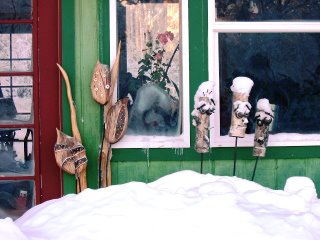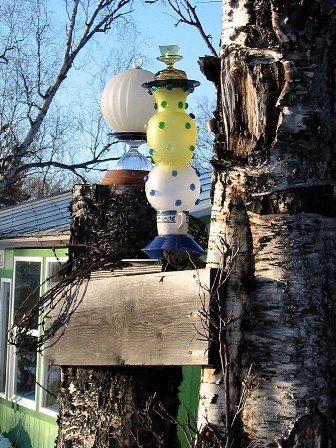
Looking at the brown mess in the garden I can’t help but wish someone had my Mother’s Day covered. There are still my garden beds to clean up. If I’d done it in the fall I’d be home free, but, the pre-snow winds would have redistributed my soil to the inlet and beyond. At least, that’s my excuse. Usually, there’s just me to do the cleanup of three gardens, pot up stuff in the greenhouse, dig out the over wintered pots from the cold frames, turn the compost, get the greenhouse ready for opening, do the artwork, water, stay sane, water some more, plant some more, rake, stake, and drop. Argh.
Ah, real food ! Thanks, mom.
But, hey, voila! An email from my own ‘good boy’. He’s clearing his calendar, packing his bag, coming home for a week and he’s ready to dig lilacs, divide perennials, and help his mom . . . for Mother’s Day? Right. No, the way you finagle a deal like this is you loan your young adults money. There’s nothing like owing mom and dad to keep your priorities straight when it comes to developing a love of gardening. And you don’t have to buy mom anything for Mother’s Day. You don’t have the money, anyway.
So, what are you doing for Mother’s Day this year? You’ve got all week to think about it. Actually, you’ve only got a week left to get the woman who runs your garden something to keep you out of the dog house. Here are a few tips to stay out of the penalty box:
-Dad, buy her a new rake. But, get one with an attached yard slave. Tie a nice bow around your ten year old and fix his hair.
-Kids, recycle mom’s old hand tools and spray paint the handles day-glo pink. She won’t lose them in the garden anymore. Don’t worry. If she’s not amused you can always blame it on dad.
-Want to get mom out of the house? Why not get her a garden club membership? The Valley Garden Club meets on the first Tuesday of each month (except July) at 10:30 am. Membership costs $20/calendar year. For more information call Jill Parson, 892-0993 or Florene Carney, 376-5390. For those of you in the northern end of the valley there’s North Root Big Lake Gardeners. They’ve got a full calendar of events happening on different days, so for more information call Linda Lockhart at 892-8112. Memberships are $10 per person, $15 per couple or $25 for a family.
-Does your wife throw up her hands in despair at the lumpy lawn and that dead tree you bought her at the hardware store last year? Get her a garden design consultation with a skilled professional from one of the local nurseries. Your garden will thank you and your neighbors will, too.
-Darling. Take your woman out for breakfast and a long leisurely drive, checkbook firmly tucked in your back pocket, and a little mood music on the radio. Then hit the local nurseries that are brimming with colorful plants and toys for your garden. Put a little romance in those flower beds. Think of gardening as a couple’s thing that you do so the woman who runs your weekends will let you watch the playoffs. A little champagne and showing off your skills with a wheelbarrow will do wonders for your relationship.
Remember. Mother’s Day isn’t just a day for mothers. Women think of it as a whole different anniversary than the one you usually forget. You get to shop for the whole Rose bush this time. And don’t forget the chocolates!
Stop in and visit Brooke this month at WoolWood Studio & Gardens up on Lazy Mountain in Palmer. www.woolwood.blogspot.com, 746-3606.
























